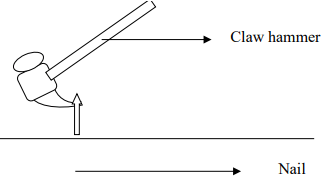Common Mistakes Made in ICSE Class 10 Board Exams Chapter Machines

This blog post aims to draw attention to some common mistakes that students make in one of the scoring chapters, Machine, in their ICSE 10 physics papers. CISCE's assessment of pupil performance serves as the foundation for these analyses.
By Topperlearning Expert 15th Feb, 2024 | 10:50 am
ShareThe machine is one of the chapters some students prefer to skip while preparing for their ICSE class 10th board exam. However, this can be a grave mistake since this chapter covers various crucial topics related to simple machines and their application. Furthermore, a lot of students often make some common mistakes while answering the questions from this chapter in their board exams.
Our goal in writing this blog is to highlight these common mistakes and provide insights to students so that they can maximise their board examinations.
Mistake to avoid while answering questions related to class and M.A of a lever.
For example:
While answering the questions given below students made some common errors which must be avoided:
Q.
(i) Identify the class of lever shown in the figure below:
(ii) How is it possible to increase the M.A. of the above lever without increasing its length?
Here are some common students made while answering these questions in their board exam.
- Students struggled to identify the class of lever.
- Students must avoid drawing a rough diagram for the explanation, instead draw a fair diagram only when asked specifically since it takes lots of your precious time which can be used in answering other scoring questions.
- Some students missed the last part of the question “without increasing its length” and simply answered “By increasing the effort arm, the M.A of the above lever can be increased” which is not correct. The main reason for this kind of error is because students learn by rote.
- Some students incorrectly wrote "by increasing load or by decreasing effort" without understanding proportional changes in effort.
- Few students correctly wrote, "change the position of load and effort” without realising that the class of lever would change.
The ideal answer for the above question is:
(i) Class III lever
(ii) By shifting effort away from the fulcrum/ towards the load Or Shifting load towards effort/decreasing the load arm.
Here are some tips for students to enhance their understanding of levers and mechanical advantages:
- Use diagrams to correctly identify different classes of levers and understand their characteristics.
- Learn various methods to increase and decrease the effort arm in lever systems.
- When the lengths of the lever arms are unequal, increasing the length of the effort arm or decreasing the load arm can increase the mechanical advantage (M.A.).
- When the lengths of the lever arms are equal, shifting the positions of the load and effort within the length of the lever can increase the mechanical advantage.
Mistakes to avoid while answering the diagram-based questions from the pulley system.
For example: While answering the questions given below students made some common errors which must be avoided:
Q. A block and tackle system of pulleys has a velocity ratio of 4. Draw a neat, labelled diagram of the system indicating clearly the points of application and direction of load and effort.
Students are supposed to draw the above diagram for this question, but they might make some common as given below while answering such questions in their board exam:
- Failing to show a fixed support in the diagram of the pulley system.
- Drawing loose strands or ropes in the diagram.
- Making incorrect connections between the pulleys and the ropes or strands.
- Neglecting to mark the directions of either/both load and effort in the diagram.
- Drawing rough sketches of the pulleys instead of accurately representing them.
- These mistakes can lead to errors in the calculation of the velocity ratio and other related quantities, resulting in lower scores on the exam.
Here are some tips for students to improve their scores while answering such questions.
- Practice drawing accurate and labelled diagrams of pulley systems and learn how to mark the tension force in the strings.
- Practice solving problems with both odd and even velocity ratios to gain a better understanding of the concept.
- Clarify the concept of velocity ratio for a given design of the machine and learn how friction or weight of the parts of the machine can affect the velocity ratio.
- Regularly revise and practice questions related to pulley systems to improve your understanding and performance in the exam.
Important tips for students.
Here are a few tips to ace their exam, for those who are going to appear for ICSE 10th board exams this year.
- Underline the keywords in the definition or in answering reasoning questions.
- Always write the correct unit for the final answer and express the final answer as per the requirement of the question. Express the answer only in SI units unless otherwise asked.
- Comprehend the key terms/technical terms/ keywords, laws and principles before memorisation.
- Practice concept-based and application-based questions regularly. Practice numerical problems starting from simple to complex that is from direct formula-based to application/understanding-based. Give more emphasis on solving numerical problems with understanding.
- Emphasis on practice by writing rather than just reading.
- Practice diagrams regularly and think logically before drawing ray diagrams. Discourage yourself from drawing rough hand sketches when the diagram is asked in the question.
- Use the first 15 minutes of reading time judiciously to understand what is asked in the question. Keep in mind or note every bit of information given in the question.
- Write to the point rather than beating around the bush.
- Do not change the numbering system given in the question paper while writing the answers on the answer sheet.
- Practice beginning a new question on a fresh page, or after leaving 8 to 10 lines.
- Practice solving previous years’ ICSE question papers and plenty of Sample papers.
Check out a free sample paper with a reference solution provided by the experts at Topper-Learning to ace your board exam.
Practice example.
Some of the most asked questions from our ask-a-doubt platform, try to solve this on your own and check the detailed solution provided by our expert once you are done or feel stuck while answering.
Q Diagram shows a weightless lever in equilibrium. Neglect friction at the fulcrum.
(i) State the principle of moments as applied to the above lever.
(ii) Give the expression for mechanical advantage. (iii) Name the type of lever which has M.A greater than 1.\
Q. The diagram below shows a claw hammer used to remove a nail:
(i) To which class of lever does it belong?
(ii) Give one more example of the same class of lever mentioned by you in (i) for which the mechanical advantage is greater than one.
Struggling to answer these questions? Click here, to check the reference solution provided by Topperlearning’s experts.
Conclusion
We hope you enjoyed reading this blog and learned something new today. Avoid these common mistakes while writing your physics paper. Also, check out our free resources and learning materials.
At Topperlearning, we bring you unique e-learning experiences, providing quality resources to students all over the country. The study materials are available for CBSE, ICSE, and Maharashtra Board alongside the resources for competitive exams like JEE and NEET.
Elevate Your Learning Journey: 5 Key Factors to Consider When Selecting Your Ideal Online Learning Platform!
More from Education
Important Resources
- Education Franchisee opportunity
- NCERT Solution
- CBSE Class 9 Mathematics
- NCERT Solutions for class 10 Science
- Sample Papers
- CBSE Class 9 Science
- NCERT Solutions for class 10 Maths
- Revision Notes
- CBSE Class 10 Hindi
- CBSE Class 10 English
- CBSE Class 10 English
- CBSE Class 10 Social Studies
- CBSE Class 10 Science
- CBSE Class 10 Mathematics
- Career In Science After 10
- Career In Commerce After 10
- Career In Humanities/Arts After 10
- NCERT Solutions for Class 10
- NCERT Solutions for Class 11
- Business Studies Class 12 CBSE project





